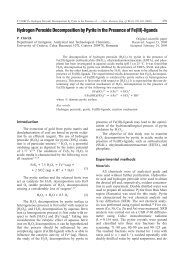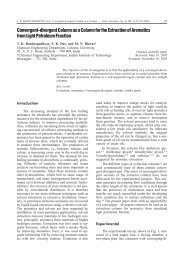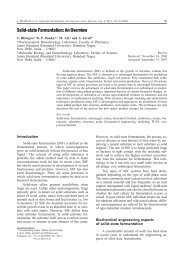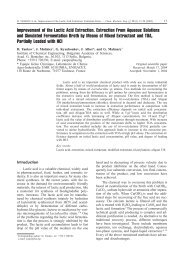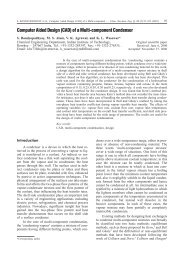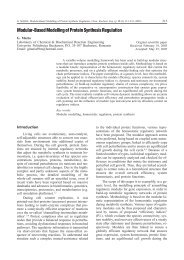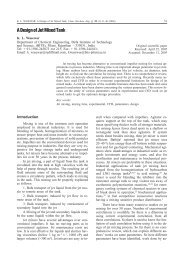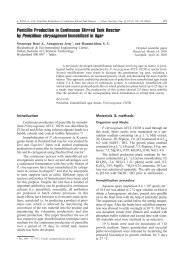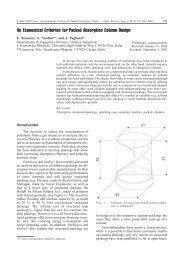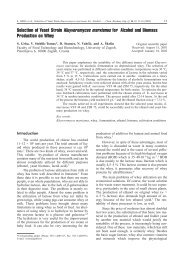Thymol Hydrogenation in Bench Scale Trickle Bed reactor - pierre
Thymol Hydrogenation in Bench Scale Trickle Bed reactor - pierre
Thymol Hydrogenation in Bench Scale Trickle Bed reactor - pierre
You also want an ePaper? Increase the reach of your titles
YUMPU automatically turns print PDFs into web optimized ePapers that Google loves.
260 J. DUDAS et al., <strong>Thymol</strong> <strong>Hydrogenation</strong> <strong>in</strong> <strong>Bench</strong> <strong>Scale</strong> <strong>Trickle</strong> <strong>Bed</strong> Reactor, Chem. Biochem. Eng. Q. 19 (3) 255–262 (2005)<br />
Fig. 8 – Steady state temperature profile <strong>in</strong> the bed at<br />
different thymol mass fraction and feed rate 1.3<br />
kg h –1<br />
Fig. 9 – D/L Menthol content <strong>in</strong> reaction product and<br />
mean temperature vs time on stream (TOS) at<br />
~1.3 kg h –1 and thymol mass fraction 13 and<br />
20 % wt.<br />
However, the temperature rise at the next 100 mm<br />
is more than 85 °C and the maximum temperature<br />
is slightly above 200 °C, which is too high <strong>in</strong> terms<br />
of process selectivity. The utilisation of catalyst at<br />
such a high concentration is also low and the part of<br />
catalyst bed dedicated to hydrogenation (the first<br />
part of the reaction sequence) is longer, therefore<br />
the part of the catalyst used for equilibration of<br />
racemic mixture is shorter, which negatively affects<br />
selectivity of the process.<br />
The most important process characteristics are<br />
complete thymol conversion and D/L menthol content<br />
<strong>in</strong> product above 55 % wt. Complete conversion<br />
of thymol and the chemical equilibrium of the<br />
outlet stream was achieved at experimental conditions<br />
used <strong>in</strong> the study. Thus, it is also evident that<br />
the reaction order with respect to thymol is close to<br />
zero.<br />
<strong>Thymol</strong> hydrogenation is exothermic and a<br />
temperature profile <strong>in</strong> the catalyst bed was observed.<br />
A mean temperature was therefore used to<br />
express dependence of product composition on<br />
temperature <strong>in</strong> the process, s<strong>in</strong>ce to use s<strong>in</strong>gle temperature<br />
is irrelevant. The mean catalyst temperature<br />
was def<strong>in</strong>ed as the mean <strong>in</strong>tegral value calculated<br />
along the catalyst bed. Temperature dependence<br />
of D/L menthols content <strong>in</strong> reaction product is<br />
depicted <strong>in</strong> Figure 9.<br />
Apparently, D/L menthol mass fraction depends<br />
ma<strong>in</strong>ly on the mean temperature <strong>in</strong> the bed<br />
(provided that complete conversion of thymol is<br />
achieved) and pressure (1.5 MPa versus 0.9 MPa),<br />
which <strong>in</strong>dicate that the product stream composition<br />
is controlled by reaction thermodynamics and not<br />
k<strong>in</strong>etics.<br />
Catalyst activity and deactivation<br />
<strong>Thymol</strong> hydrogenation was performed <strong>in</strong> several<br />
cycles to <strong>in</strong>vestigate an effect of the recycle of<br />
the menthol mixture on the process performance.<br />
The catalyst was kept under hydrogen at ambient<br />
temperature dur<strong>in</strong>g the idle period. It was found,<br />
that this preserved the catalyst with no degradation<br />
of performance be<strong>in</strong>g observed. The catalyst activity<br />
was tested periodically at standard process conditions<br />
(liquid flow rate Q L = 1 kg h –1 , 20 % wt.<br />
thymol fraction at 1.5 MPa) and the same temperature<br />
profile was observed after more than 500 hours<br />
time on stream. It was however found that the <strong>reactor</strong><br />
overheat<strong>in</strong>g (above 350 °C) had a detrimental<br />
effect on catalyst performance. Catalyst overheat<strong>in</strong>g<br />
can be caused by the exotherm from the side reaction<br />
(decomposition of menthol), low liquid flow<br />
rates or failure of the feed <strong>in</strong>troduction <strong>in</strong>to the system,<br />
too high temperature <strong>in</strong> preheat<strong>in</strong>g zone, too<br />
high thymol concentration <strong>in</strong> the feed at adiabatic<br />
conditions or low hydrogen partial pressure.<br />
The catalyst bed temperature exceeded 200 °C<br />
dur<strong>in</strong>g several of the experiments conducted without<br />
any effect on the catalyst activity. The ‘hot spot’<br />
was situated mostly at a position 100 mm from the<br />
top of the catalyst bed and its position was <strong>in</strong>fluenced<br />
by the liquid flow rate, the feed concentration,<br />
and to a lesser extent by gas flow rate. The<br />
trickle bed <strong>reactor</strong> worked at almost adiabatic conditions<br />
and the temperature profile was determ<strong>in</strong>ed<br />
and/or controlled by preheat<strong>in</strong>g zone temperature<br />
TW3.<br />
Dur<strong>in</strong>g hydrogenation at standard conditions<br />
(20 % wt. thymol feed) due to the failure of control<br />
system, the temperature TW3 <strong>in</strong>creased above the<br />
required value (> 200 °C). Temperature runaway<br />
was observed as a consequence of overheat<strong>in</strong>g of<br />
the preheat<strong>in</strong>g section. The temperature runaway<br />
occurred on the first 100 mm of the catalyst bed.<br />
Both, the liquid feed and hydrogen were stopped,<br />
and hydrogen was replaced by nitrogen. The maximum<br />
temperature <strong>in</strong> the zone was 420 °C for approximately<br />
5 m<strong>in</strong>. The system was cooled down to



